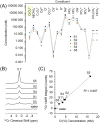Determining hexavalent chromium transport properties in alkaline nuclear waste using nuclear magnetic resonance spectroscopy
- PMID: 40483379
- PMCID: PMC12145419
- DOI: 10.1038/s42004-025-01546-7
Determining hexavalent chromium transport properties in alkaline nuclear waste using nuclear magnetic resonance spectroscopy
Abstract
This study focuses on the transport properties of hexavalent chromium, specifically the chromate anion, to improve predictive models and environmental remediation strategies for Cr(VI) migration. Using 53Cr Nuclear Magnetic Resonance (NMR) spectroscopy, the research quantifies chromate in multicomponent electrolytes replicating nuclear waste conditions at the Hanford Site in Washington State. The consistency of the 53Cr NMR signal integral with chromate concentration, despite varying matrix compositions, establishes it as a reliable concentration indicator. The transport properties of chromate in an alkaline solution were assessed using relaxation-based measurements via saturation recovery and Carr-Purcell-Meiboom-Gill experiments, determining spin-lattice and spin-spin relaxation times. These measurements, combined with the Bloembergen-Purcell-Pound equation, helped estimate the rotational correlation time and the 53Cr self-diffusion coefficient using Stokes-Einstein-Debye and Stokes-Einstein equations. Direct measurements were obtained through pulsed field gradient stimulated echo 53Cr NMR spectroscopy. Monte Carlo simulations further estimated uncertainty propagation. The results enhance comprehension of chromate transport and highlight prospects for identifying transport properties of NMR-active nuclei, traditionally considered unreachable.
© 2025. Battelle Memorial Institute and Jacob Reynolds.
Conflict of interest statement
Competing interests: The authors declare no competing interests.
Figures




References
-
- Owlad, M., Aroua, M. K., Daud, W. A. W. & Baroutian, S. Removal of hexavalent chromium-contaminated water and wastewater: a review. Water Air Soil Pollut.200, 59–77 (2009).
-
- Peterson, R. A. et al. Review of the scientific understanding of radioactive waste at the U.S. DOE Hanford site. Environ. Sci. Technol.52, 381–396 (2018). - PubMed
-
- Lumetta, G. J. & Rapko, B. M. Removal of chromium from Hanford tank sludges. Sep. Sci. Technol.34, 1495–1506 (1999).
-
- Wanner, C., Eggenberger, U. & Mäder, U. A chromate-contaminated site in southern Switzerland—part 2: reactive transport modeling to optimize remediation options. Appl. Geochem.27, 655–662 (2012).
-
- Thery, G. et al. Heating effect on chromium speciation and mobility in Cr-rich soils: a snapshot from New Caledonia. Sci. Total Environ.922, 171037 (2024). - PubMed
LinkOut - more resources
Full Text Sources

